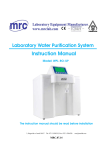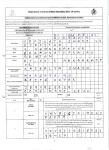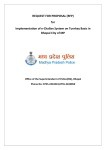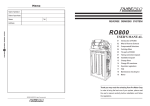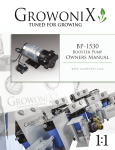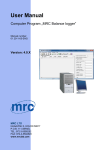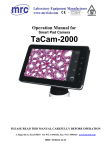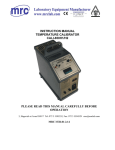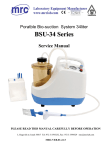Download Instruction Manual
Transcript
Laboratory Water Purification System Instruction Manual Model: WPB-RO Series The instruction manual should be read before installation Hagavish st. Israel 58817 Tel: 972 3 5595252, Fax: 972 3 5594529 [email protected] MRC.VER.01-.13 Laboratory Water Purification System Instruction Manual 1. Preface Dear customer, in the beginning, we sincerely thanks for your choosing our water purification system. This water purification system has incorporated new cutting-edge technology. It is installed and used easily, and can provide you with RO water and ultra pure water for science research. So, it will benefit your work. For the water purification system’s maximum efficiency, it is suggested that the user manual be read before installation. Any question in the installation process, please contact our technology engineers or dealers. 2. Specification WPB-RO Model Water Desalination rate >95%* quality TDS(RO water) TDS(Total dissolved solid) of RO water(ppm):<TDS of inlet water×5% Automatic electronic pressure sensor controlling, RO membrane auto flushing, Control system automatic stop without water, automatic stop when water tank full, automatic cutting off water when pump stopping, guaranteeing 24 hours’ work. Output 15 liters/hour* Technical Power 220V/50Hz,48W specification Dimension Weight Inlet water requirement W×D×H:41cm×22cm×42cm About 18KG Tap water: TDS<200ppm,5-45℃,1.0-4.0Kgf/cm Sequence number 2 Specifitation Quantity/set LV.1 Special spun fiber filter 1 Purification LV.2 Special active carbon block filter 1 system LV.3 Special active carbon block filter 1 LV.4 100GPD RO membrane 1 LV.5 Post active carbon filter 1 Remarks : Inlet water:TDS<200ppm, 25℃, 50psi and 15% recovery rate. GPD=gallon per day.1gallon=3.78liters. The quality of inlet water will effect pure water’s quality of outlet and cartridge’s life. Output of 100 gallons per day is measured under the temperature of 25℃. When the temperature is lower than 25℃,the water output will be less than100 gallons per day. 3. Water Flow Chart: 1/7 Laboratory Water Purification System Instruction Manual 4. Working Environments: Inlet water: Tap water (TDS<200ppm will be suggested). If inlet water TDS>200ppm, pretreatment is recommended. Water with higher TDS will affect the quality of outlet water and life of purification cartridge. Work temperature: 5-45℃ Pressure: 1.0-4.0Kgf/cm Power: 220V/50Hz,48W 2 【Clean, dry working environments would be suggested!】 5. Installation Step: The purification system should be installed horizontally and near to tap water. Tube installation and drag The adapter of the machine is high quality easy-put adapter. Proper usage is as follows: Connect the tube: press the oval cap of the interface strongly, then insert the tube to the bottom of adapter. Take off the tube: press the oval cap of the interface strongly, then drag out the tube. Do not drag when the tube can not be dragged out any more. Tube Installation And Drag All cartridges have been installed in the factory. Additional cartridges installation is unnecessary. Check the accessory box. According to the “instaIlation guide chart” in the instruction manual, install the machine with the adapters, tube and pretreatment filters(optional) in the accessory box. Connect with the water tank, electrical source and tap water. At the end, turn on the power switch and the tap water source valve, then the machine will produce pure water. Specific installation steps are as follows: st (1). Connect to tap water-1 step: Shut off the chief switch of tap water, dismantle the tap, connect the water source with 3-direction-links in the accessories, and then connect the tap with 3-direction-links, connect another direction of 3-direction-links with plastic ball valve. At last, open the chief switch of tap water. (2). Connect to tap water-2 nd step: Use 1/4” PE tube with a suitable length. One side connects with the plastic ball valve, and the other connects with the interface with blue label marked “To inlet water” at the side of machine. 2/7 Laboratory Water Purification System Instruction Manual (3). Connect to drain: Use 1/4” PE tube with a suitable length. One side connects with the interface with black label marked “To drain” at the side of machine, and the other side is directed to gutter. (Do not jam) (4). Connect to water tank: Install the plastic ball valve on the pressure tank. Use 1/4” PE tube with a suitable length. One side connects with the interface with yellow label marked “To water tank” at the side of machine, and the other connects with the plastic ball valve. Thus the installation is OK. 3/7 Laboratory Water Purification System Instruction Manual Installation Guide Chart RO water outlet: Application: ware washing,agricultural expe,general biological expe,aquatic products feeding,inlet water for ultra pure water machine,inlet water for sterilizer/ t&h chamber Main body Water tank ball valve(optional) Spare interface Tap water adapter 1 pretreatment filter(optional) 3 gallon water tank(optional) RO membrane drain (Do not jam) OR plastic ball valve 4/7 Tap water tap water adapter 23-direction-links Laboratory Water Purification System Instruction Manual 6. Usage Guide All data have been set in the factory. The machine will operate smoothly without any data-setting. The switch of pure water outlet is on the side of the shell. Specific picture is as follows: Press this side to get RO water. Stand by to produce RO water to store in the water tank, Starting up: Turn on the tap water valve and insert the power line into the power source, then the system begins to produce pure water. Getting RO pure water: Press the switch to“I”, which is on the side of the box, to get RO water. When getting water process is ok, press the switch to “O” position. Standby: When RO water is not for use, the system will be in standby state. The system still produce RO water to store in the water tank(optional). Until tank is full, the system will automatically stop. The system will begin to produce pure water again when pure water is used. Shutdown: Turn off the tap water valve and drag out the power line. Then it is ok. Attention: Make sure that the water source and power source is not connected when the system is not in the use state for long time. The usage to keep high quality pure water: (1). The pure water is easily polluted by surrounding environment. So getting fresh pure water is suggested. (2). Keep source water tank from sunlight for microbe’s reproducing. (3). When get high pure water, initial high pure water is suggested to drain to get steady pure water. (4). Avoid air bubble when get pure water to reduce air pollution. Attention: The microbe’s reproducing will reduce the life of filter cartridge when the machine does not work for long time. So the machine’s work every 7-10days is necessary. 7. Water Quality Test The system has 1 method of water quality measuring. TDS pen. which is used to testing reverse osmosis water and tap water’s quality. Measure unit: TDS(total dissolved solid, ppm) Remarks: Conversion relations between TDS and conductivity rate(µs/cm): If TDS<50ppm, conductivity rate(µs/cm) ≈TDS×2 5/7 Laboratory Water Purification System Instruction Manual If TDS>200ppm, conductivity rate(µs/cm) ≈TDS×(1.5~1.7) If TDS of RO water < TDS of inlet tap water×10%(under normal conditions, TDS of RO water is around TDS of inlet tap water×5%), RO membrane is ok. If TDS of RO water > TDS of inlet tap water×10%, Replacing RO membrane is essential for proper pure water. 8. Accessories Item No. Specification Quantity/set Suggested replacement term PC-PP-ZK Special spun fiber filter 1 About 2-6 months PC-AC-B-ZK Special active carbon block filter 1 About 4-6 months PC-AC-B-ZK Special active carbon block filter 1 About 4-6 months RO-100GPD 100GPD RO membrane 1 About 12-24 months PTC-AC-HZS Post active carbon filter 1 About 6800 liters pure water Remarks: Worse inlet source water quality or big dosage will reduce the life of cartridge above. RO membrane Post active carbon filter 9. Trouble Diagnosis Ⅰ. Motor failure A. Check whether the pressure of the tap water is high enough. When pressure is low, low pressure switch will cut off power. B. Check whether the high pressure switch or water level controllor is normal. C. Check whether special PP filter or Active carbon is blocked which cause the overload of the motor. D. Check whether control panel is OK (for full automatic model) Ⅱ. Pump Leaking A. Check whether special PP filter or Active carbon is blocked which cause the overload of the motor. Then high pressure lead to leaking. Resolution: change special PP filter or Active carbon and repair the pump. B. The expiring of the pump rubber membrane or the dirt will cause leaking too. Please repair the pump and pay attention to checking the LV. 1-special PP cotton. C. The block of the waste water proportion vessel will cause the block of the reverse membrane. Then pressure increase. Water with high pressure will break the pump rubber membrane, then causes leaking. Change relative components will be ok. Ⅲ. Motor working but no water RO membrane is blocked or pump’s pressure lost. For the former, change the RO membrane; For the later, check whether expiring of pump is caused by long time overload or blocking of the cartridge. Repair motor. 6/7 Laboratory Water Purification System Instruction Manual Ⅳ.Motor works ever and again The motor works ever and again. It is the reason that low pressure or blocking of LV.1cartridge. Please install a booster pump or replace LV.1cartridge. Ⅴ.The pressure tank is full of water, but pure water can not flow out A. Air in the pressure tank leaks. Please fill it with 7psi air and check whether air leaks. If air can not be put into tank, change the pressure tank.. B. Backset active carbon is blocked. Please replace it with a new one. Ⅵ. Power is off, but RO water does not stop flowing. A. Check the four-side water circuit breaker, and replace it if it goes wrong. B. Pressure of inlet water is higher then the set pressure of high pressure switch. Please regulate the pressure of inlet water no more then 2kg/cm2. Ⅶ. The machine can not stop running when pressure tank is full of water or it runs at once after one stop. A. High pressure switch or liquid level controller goes wrong. Repair it if it works after repairing, otherwise, replace it with a new one. B. Non-return valve leaks pressure so that it can not close. Replace it please. 10. Warranty & Repair Regulation The products customers buy form our company enjoy repair service since the day of purchase. In on year form the purchasing day, our company is obliged to replace components free of charge due to non-human-behavior factors except: (1). Damage caused by maloperation or use in abnormal situations. (2). Disassembly any part of the machine or human-behavior damage. (3). Not repaired by our serviceman. Specification can be changed without any prior notice for development 7/7








